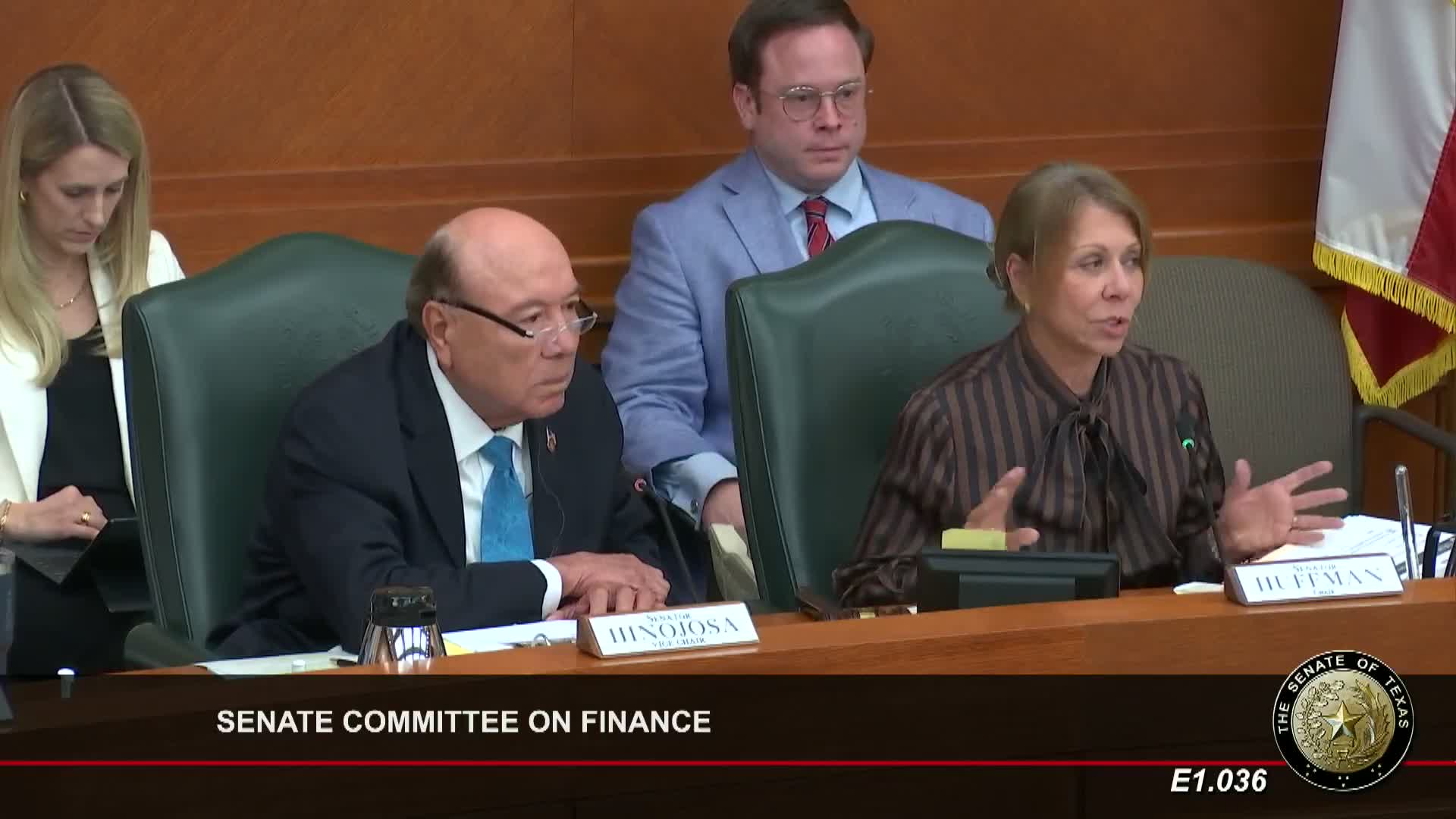A&M research and training agencies pitch workforce investments and emergency preparedness funding
February 07, 2025 | Senate, Legislative, Texas
This article was created by AI summarizing key points discussed. AI makes mistakes, so for full details and context, please refer to the video of the full meeting. Please report any errors so we can fix them. Report an error »

Several Texas A&M system agencies and affiliated programs presented funding requests and program updates to the Senate Finance Committee, emphasizing workforce development, disaster readiness and laboratory staffing needs.
Cliff Lam, director of Texas A&M AgriLife Research, asked the committee for $26,000,000 over the biennium for an “intelligent agricultural systems” initiative. Lam said intelligent equipment, predictive analytics and staffing will improve farm productivity and help Texas producers adapt to shifting global demand. He gave an example of a pilot where predictive models allowed early cotton harvest and materially impacted farm revenue.
Rick Avery, director of Texas A&M AgriLife Extension Service, told senators extension serves Texan communities through 250 offices and operates a disaster assessment and recovery (DAR) unit. He thanked the committee for funding under Keeping Texas Prepared and asked for $19,700,000 in the biennium to expand the DARR unit, hire additional subject matter specialists and support county‑level monitoring and outreach. Avery said extension’s DAR teams completed more than 2,000 damage assessments in 2024 and that extension also supports youth programs that reach hundreds of thousands of children.
David Coatney, TEEX agent director, outlined workforce and preparedness proposals including $8,000,000 to expand workforce training in cybersecurity, robotics and manufacturing (noting new training sites in the Rio Grande Valley and Corpus Christi), $9,000,000 to scale Keeping Texas Prepared community cybersecurity and exercises, and $17,000,000 one‑time to expand Disaster City and simulate indoor/subterranean rescues.
Dr. J. R. Swinford of the Texas A&M Veterinary Medical Diagnostic Laboratory (TVMDL) described how TVMDL drove the state’s response to a 2024 animal health emergency, identifying highly pathogenic avian influenza (HPAI) in unexpected species and emphasizing the lab’s role in surveillance and zoonotic risk mitigation. TVMDL asked for additional funds to retain and recruit veterinary and molecular diagnostics personnel, citing a retirement eligibility rate of roughly 20% in professional staff and a growing national market premium for veterinary specialists.
Nut graf: The A&M agencies combined message to the committee linked workforce pipelines, disaster readiness and lab capacity: extension and TEEX sought continued and expanded Keeping Texas Prepared support to staff regional warehouses, training and community resilience; AgriLife Research asked for investments to modernize production with predictive tools; and TVMDL warned that recruitment and salary gaps threaten the state’s diagnostic capacity.
Ending: Agency leaders said they would follow up with the committee on details and thanked senators for past supplemental funding, noting that the proposed investments are meant to reduce long‑term state costs by improving local capacity and preventing deobligations of federal funds.
Cliff Lam, director of Texas A&M AgriLife Research, asked the committee for $26,000,000 over the biennium for an “intelligent agricultural systems” initiative. Lam said intelligent equipment, predictive analytics and staffing will improve farm productivity and help Texas producers adapt to shifting global demand. He gave an example of a pilot where predictive models allowed early cotton harvest and materially impacted farm revenue.
Rick Avery, director of Texas A&M AgriLife Extension Service, told senators extension serves Texan communities through 250 offices and operates a disaster assessment and recovery (DAR) unit. He thanked the committee for funding under Keeping Texas Prepared and asked for $19,700,000 in the biennium to expand the DARR unit, hire additional subject matter specialists and support county‑level monitoring and outreach. Avery said extension’s DAR teams completed more than 2,000 damage assessments in 2024 and that extension also supports youth programs that reach hundreds of thousands of children.
David Coatney, TEEX agent director, outlined workforce and preparedness proposals including $8,000,000 to expand workforce training in cybersecurity, robotics and manufacturing (noting new training sites in the Rio Grande Valley and Corpus Christi), $9,000,000 to scale Keeping Texas Prepared community cybersecurity and exercises, and $17,000,000 one‑time to expand Disaster City and simulate indoor/subterranean rescues.
Dr. J. R. Swinford of the Texas A&M Veterinary Medical Diagnostic Laboratory (TVMDL) described how TVMDL drove the state’s response to a 2024 animal health emergency, identifying highly pathogenic avian influenza (HPAI) in unexpected species and emphasizing the lab’s role in surveillance and zoonotic risk mitigation. TVMDL asked for additional funds to retain and recruit veterinary and molecular diagnostics personnel, citing a retirement eligibility rate of roughly 20% in professional staff and a growing national market premium for veterinary specialists.
Nut graf: The A&M agencies combined message to the committee linked workforce pipelines, disaster readiness and lab capacity: extension and TEEX sought continued and expanded Keeping Texas Prepared support to staff regional warehouses, training and community resilience; AgriLife Research asked for investments to modernize production with predictive tools; and TVMDL warned that recruitment and salary gaps threaten the state’s diagnostic capacity.
Ending: Agency leaders said they would follow up with the committee on details and thanked senators for past supplemental funding, noting that the proposed investments are meant to reduce long‑term state costs by improving local capacity and preventing deobligations of federal funds.
View full meeting
This article is based on a recent meeting—watch the full video and explore the complete transcript for deeper insights into the discussion.
View full meeting
